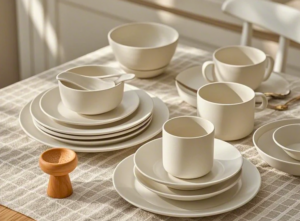How Do Factories Test Whether Melamine Dinnerware Is Safe
Home » How Do Factories Test Whether Melamine Dinnerware Is Safe
RECENT POSTS
Share:
- January 29, 2025
Table of Contents
Melamine dinnerware is widely used for its durability, attractive designs, and affordability. However, due to concerns about food safety and potential health risks, factories need to conduct rigorous testing to ensure that melamine dinnerware is safe for consumers. Testing processes focus on assessing the migration of melamine and formaldehyde from the dinnerware into food, as well as evaluating its structural integrity under various conditions. This article outlines the primary safety tests that factories perform to ensure melamine dinnerware meets industry standards.
Key Testing Methods for Melamine Dinnerware
1. Migration Testing
Migration testing is one of the most critical safety assessments for melamine dinnerware. The process evaluates whether harmful substances, such as melamine or formaldehyde, leach into food when the dinnerware is exposed to different conditions like heat, acidic substances, or prolonged contact.
Factories typically test melamine dinnerware by placing it in contact with food simulants—substances that mimic real food in terms of chemical composition. For example, an acidic food simulant may be used to test the migration of melamine when the dinnerware is exposed to sour foods like vinegar or citrus. The dinnerware is heated to simulate normal usage conditions, typically between 70°C to 100°C (158°F to 212°F), and then left for a set period, such as 2-4 hours.
The test results are measured in milligrams per kilogram (mg/kg) of food simulant. According to international safety standards, the migration of melamine from dinnerware should not exceed 2.5 mg/kg. This threshold ensures that the dinnerware is safe for regular use and does not pose a risk of contamination.
2. Formaldehyde Migration Testing
Formaldehyde, a potential carcinogen, is used in the production of melamine resin. While melamine dinnerware is typically considered safe under normal conditions, testing for formaldehyde migration is crucial to ensure there is no excessive release into food. Formaldehyde migration testing follows a similar procedure to melamine migration testing, using food simulants to assess the potential for formaldehyde to leach from the dinnerware.
Factories will expose the dinnerware to high temperatures and acidic conditions to simulate real-life usage scenarios, such as microwaving or washing with detergents. The formaldehyde content in the food simulant is then analyzed to ensure it falls within the safety limits set by regulatory bodies like the U.S. Food and Drug Administration (FDA) and the European Food Safety Authority (EFSA).

Additional Safety Tests for Melamine Dinnerware
1. Durability Testing
Beyond chemical migration, melamine dinnerware must be tested for physical durability to ensure it can withstand normal wear and tear. This includes testing for cracking, chipping, and discoloration. Factories subject melamine dinnerware to mechanical stress, such as dropping the items from a specified height or applying pressure to simulate everyday use. Items that fail these tests may not be considered safe for consumers, as cracks or chips can harbor bacteria or release harmful chemicals.
Additionally, durability tests often include exposure to repeated cycles of washing and cleaning, both by hand and in dishwashers. Melamine dinnerware that maintains its structural integrity after hundreds of wash cycles is deemed more reliable and safe for long-term use.
2. Thermal Shock Resistance
Thermal shock resistance is another important factor in testing the safety of melamine dinnerware. This test evaluates the ability of the dinnerware to withstand sudden temperature changes, such as when hot food is placed on a cold plate or when the dinnerware is exposed to extreme heat in a microwave or oven. Factories may perform thermal shock tests by rapidly changing the temperature of the melamine dinnerware, typically from -20°C to 100°C (-4°F to 212°F).
Dinnerware that can resist thermal shock without cracking or warping is considered safer and more durable. Items that fail the test may pose a risk of breakage during normal use, creating potential hazards for consumers.
Regulatory Standards and Compliance
1. International Safety Standards for Melamine Dinnerware
To ensure the safety of melamine dinnerware, factories must comply with various international standards. The European Union’s Regulation (EC) No. 1935/2004 sets strict guidelines for materials that come into contact with food, including melamine resin. Similarly, in the U.S., the FDA provides regulations on the safe use of melamine-based products in food contact materials. These regulations require manufacturers to conduct migration testing and ensure that no harmful substances leach into food.
Manufacturers must also adhere to ISO (International Organization for Standardization) standards, which provide a global framework for ensuring product safety and quality. For example, ISO 22000 covers food safety management, and manufacturers of melamine dinnerware are expected to follow these guidelines to minimize risk and ensure consumer protection.
Conclusion
The safety of melamine dinnerware is a critical concern for both manufacturers and consumers. Factories use a combination of migration testing, durability tests, and thermal shock resistance assessments to ensure that melamine dinnerware is safe for everyday use. By following strict safety standards and conducting comprehensive testing, factories can provide high-quality products that meet consumer expectations without compromising health or safety.
0


